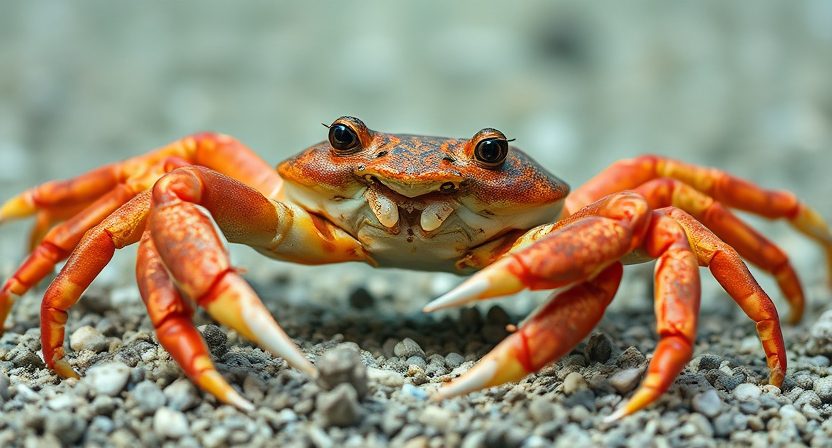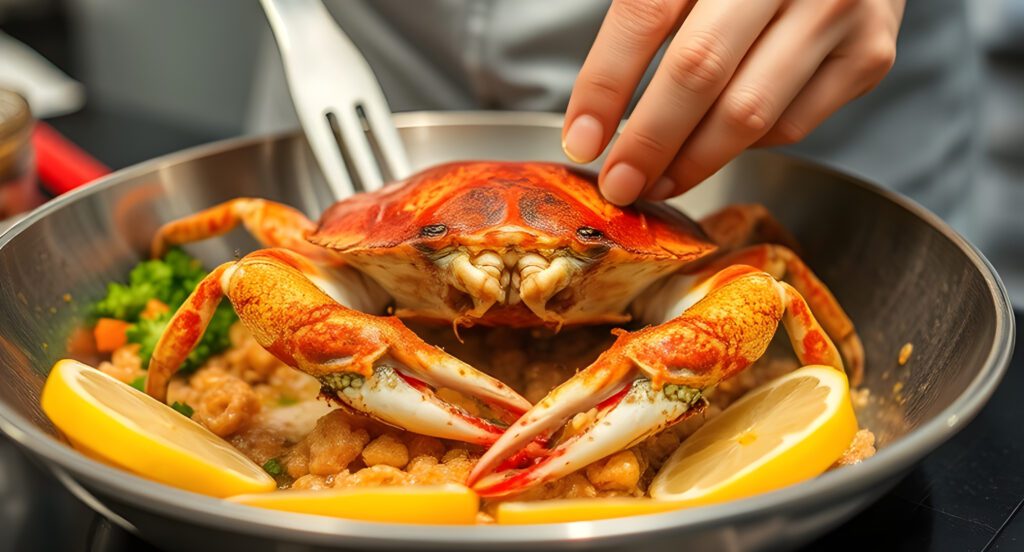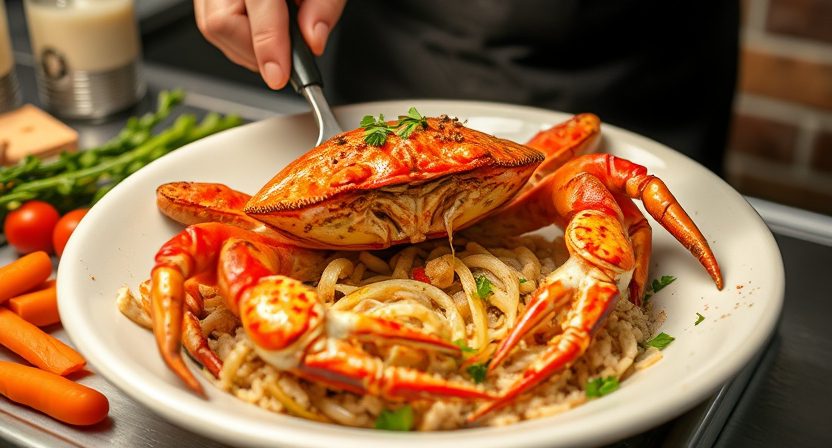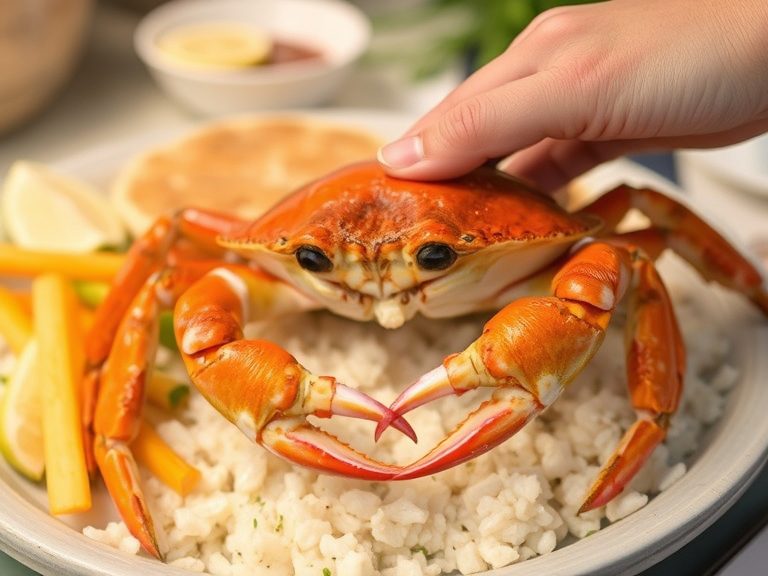Many people wonder, “Is Eating Devil Crab Safe for Consumption?” The answer is yes, but only when properly handled, prepared, and cooked. Understanding the potential risks and best practices can help ensure a safe and enjoyable seafood experience.
Introduction to Devil Crab Safety
Eating devil crab can spice up your seafood meals. But, food safety is crucial. By understanding risks and taking steps to avoid them, you can enjoy devil crab safely.
Key Takeaways
- Devil crab can be a safe and delicious addition to a seafood diet
- Proper handling, preparation, and cooking are essential to minimize devil crab health risks
- Understanding the potential health risks associated with devil crab is crucial for making informed decisions
- Devil crab health risks can be mitigated by taking necessary precautions
- Eating devil crab can be a great way to add variety to your seafood diet
- Food safety should always be a top priority when consuming devil crab

1. Understanding Devil Crab: What Makes It Unique
Devil crab is a favorite in many seafood dishes but can be risky if not cooked right. Knowing its physical traits, where it lives, and its cultural importance is key. Cooking it the right way can make it taste and feel better.
The devil crab’s shell and claws help identify it. It lives in different places, making it interesting to study. Its home and where it’s found can affect how it tastes and feels when cooked.
Physical Characteristics and Identification
Devil crab stands out with its bright shell and special claw shape. These traits help spot it and make it a sought-after food. When cooking, these features are important to keep the crab safe and tasty.
Natural Habitat and Distribution
Devil crab lives in warm, sunny areas, like coral reefs and rocky spots. Its home depends on water conditions and food. Knowing where it lives helps catch it sustainably and protect the environment.
Cultural Significance in Seafood Cuisine
In many places, devil crab is a key ingredient in traditional dishes. Its taste and texture are loved by seafood fans. Cooking it right is key to enjoying its flavor and staying safe.
| Characteristics | Description |
|---|---|
| Shell Color | Vibrant, ranging from blue to red |
| Claw Shape | Distinctive, with a curved shape |
| Natural Habitat | Coral reefs, rocky crevices |
2. Is Devil Crab Safe to Eat? The Expert Verdict
Eating Devil Crab: Is It Safe? Many people have concerns about whether devil crab is safe to eat. Understanding proper consumption guidelines and preparation methods is essential for enjoying this seafood delicacy without health risks. Experts agree that when handled and cooked correctly, devil crab can be both safe and delicious.
Proper preparation is crucial to ensure safety. This includes storing devil crab at the right temperature, maintaining cleanliness during handling, and cooking it to the recommended internal temperature. By following these precautions, you can safely enjoy devil crab while minimizing the risk of foodborne illness.

- Checking the freshness of the crab before purchase
- Storing crab in a sealed container at a temperature below 40°F
- Cooking crab to an internal temperature of at least 145°F
By following these steps and being careful, you can enjoy devil crab’s unique taste and health benefits. Always put food safety first and handle devil crab with care to avoid getting sick.
Proper handling and cooking are key to safe devil crab consumption. By following the guidelines and taking the necessary precautions, you can enjoy this delicious seafood while protecting your health.
3. Common Misconceptions About Devil Crab
There are many myths about eating devil crab. It’s important to know the truth. One myth is that devil crab is always dangerous. But, with the right knowledge and care, the risks can be lowered.
Knowing the facts about devil crab is key for those interested in trying it. Eating devil crab: what you need to know means understanding its nutritional value and health benefits. By clearing up myths and focusing on facts, people can decide if devil crab is right for their diet.
Debunking Popular Myths
- Devil crab is not always toxic; its toxicity depends on various factors, including its habitat and diet.
- Proper cooking and handling can significantly reduce the risk of foodborne illness.
- Devil crab can be a nutritious addition to a balanced diet, providing essential proteins and minerals.
Scientific Facts vs. Urban Legends
It’s crucial to trust scientific research and expert opinions on devil crab safety precautions and its benefits. This way, people can enjoy devil crab safely and make smart choices about eating it.
4. Essential Safety Precautions When Handling Devil Crab
When handling devil crab, safety is key. Proper handling and storage techniques are vital to avoid contamination and foodborne illness. It’s important to cook the crab to the right temperature to kill bacteria.
To prevent food poisoning, handle the crab safely. Keep it refrigerated at 40°F (4°C) or below. Also, cook it to an internal temperature of 145°F (63°C).
Here are more safety tips to remember:
- Wash your hands well before and after touching the crab
- Ensure all utensils and surfaces are clean and sanitized
- Cook the crab right away after thawing
By following these safety tips, you can enjoy devil crab safely. This way, you’ll avoid food poisoning symptoms.
Remember, safety always comes first when handling and cooking devil crab. By being mindful of the potential risks and taking the necessary precautions, you can have a safe and enjoyable dining experience.
5. Selecting Fresh Devil Crab: What to Look For

Freshness is crucial when picking devil crab for a safe and tasty meal. Look for a crab with a fresh smell and a firm texture. Steaming or boiling is the best way to cook it, keeping its flavor and texture intact.
A quality devil crab smells sweet and feels firm and springy. Stay away from any crab with a bad smell or a soft, mushy feel. These signs often mean the crab is spoiled or contaminated. Also, check the shell for cracks or damage, which could mean poor handling or storage.
Here are some key factors to consider when selecting fresh devil crab:
- Seasonal availability: Devil crab is typically available from March to October, with the peak season being from May to July.
- Size and weight: Choose crabs that are heavy for their size, as this indicates a higher meat content.
- Color and appearance: A fresh devil crab should have a vibrant, blue-green shell with no signs of discoloration or damage.
By considering these factors and choosing fresh, high-quality devil crab, you can ensure a delicious and safe dining experience. Whether you’re looking for the best way to cook devil crab or simply want to know if devil crab is safe to eat, selecting the right crab is the first step to a great meal.
6. Proper Storage and Handling Guidelines
To keep devil crab fresh and safe, follow these storage and handling tips. Devil crab consumption guidelines suggest storing it in a sealed container with ice. Keep it at a temperature below 40°F (4°C). When handling, be gentle to prevent damage and spoilage.
Here are some tips for how to properly prepare devil crab:
- Store the crab in a covered container to prevent moisture and other contaminants from entering.
- Keep the crab refrigerated at a consistent temperature below 40°F (4°C).
- Handle the crab gently to avoid damaging the shell or exposing the flesh.
By following these guidelines, your devil crab will stay fresh and safe. Always check for signs of spoilage before eating, like a strong smell or slimy texture.
For more information on devil crab consumption guidelines and how to properly prepare devil crab, consult with a trusted seafood expert or a reputable culinary resource.
| Storage Method | Temperature | Handling Tips |
|---|---|---|
| Sealed container | Below 40°F (4°C) | Gentle handling, avoid cross-contamination |
| Covered with ice | Below 40°F (4°C) | Monitor ice levels, avoid moisture buildup |
7. The Best Methods for Cooking Devil Crab
Cooking devil crab can be a fun experience. But, it’s key to follow safety steps for a tasty meal. Knowing how to cook devil crab right can make a big difference in taste and texture.
Steaming and boiling are classic ways to cook devil crab. They keep the crab’s natural flavor and texture. Grilling and sautéing, on the other hand, can give the dish a new flavor.
Temperature Guidelines
It’s important to cook devil crab at the right temperature. This ensures it’s not too raw or overcooked. The best internal temperature is between 145°F and 150°F.
By following these guidelines and taking safety precautions, you can have a great meal. Always put food safety first when cooking devil crab. Try different cooking methods to find your favorite way to enjoy this delicious crustacean.
| Cooking Method | Temperature | Cooking Time |
|---|---|---|
| Steaming | 145°F – 150°F | 8-10 minutes |
| Boiling | 145°F – 150°F | 10-12 minutes |
| Grilling | 145°F – 150°F | 5-7 minutes per side |
The recipe
Print
Stuffed Devil Crab Cakes
- Total Time: 30 minutes
- Yield: 4 servings
Description
The rich, indulgent flavors of these Stuffed Devil Crab Cakes take inspiration from classic Cuban cuisine. With a perfect balance of seafood sweetness, smoky paprika, and a crispy exterior, each bite is an explosion of taste. Whether enjoyed as an appetizer or a main course, these croquettes bring the vibrant flavors of the coast straight to your plate.
Ingredients
– 1 lb cooked blue crab meat, picked over for shells
– 1 small onion, finely chopped
– 1/2 small green bell pepper, finely chopped
– 2 cloves garlic, minced
– 1/4 cup butter
– 1/2 cup tomato sauce
– 1/2 teaspoon cayenne pepper
– 1 teaspoon smoked paprika
– 1 teaspoon Worcestershire sauce
– 1 teaspoon salt
– 1/2 teaspoon black pepper
– 2 tablespoons fresh parsley, chopped
– 1 cup breadcrumbs
– 1 egg, beaten
– 1/4 cup whole milk
– 1 cup fine cracker crumbs (for coating)
– Oil for frying
Instructions
1. In a skillet, melt the butter over medium heat. Add the onion, bell pepper, and garlic. Sauté for about 3 minutes, until softened.
2. Stir in the tomato sauce, cayenne pepper, smoked paprika, Worcestershire sauce, salt, and black pepper. Let simmer for 5 minutes.
3. Remove from heat and mix in the crab meat and fresh parsley. Let cool slightly.
4. In a bowl, combine the breadcrumbs, beaten egg, and milk. Mix until a dough-like consistency forms.
5. Shape the mixture into small patties or croquettes. Coat each one in fine cracker crumbs.
6. Heat oil in a frying pan to 350°F (175°C). Fry the croquettes in batches for about 3 minutes per side until golden brown and crispy.
7. Drain on paper towels and serve hot.
- Prep Time: 15 minutes
- Cook Time: 15 minutes
8. Potential Health Benefits of Devil Crab
Devil crab is not just a delicious treat but also a nutrient-rich seafood that supports a healthy lifestyle. With low fat content and high protein, it makes for an excellent choice for weight management and overall well-being.
Nutritional Benefits of Devil Crab
Devil crab offers an impressive nutritional profile, making it a valuable addition to a balanced diet. Here are some key benefits:
- High in protein – 20 grams per 3-ounce serving
- Low in fat – Only 1 gram per 3-ounce serving
- Rich in omega-3 fatty acids – 0.5 grams per 3-ounce serving
These nutrients contribute to muscle health, weight maintenance, and even brain function.
The best way to cook devil crab is through steaming or boiling, as these methods help preserve its nutrients. Unlike fried seafood dishes, which can increase calorie and fat intake, steamed crab maintains its natural flavors and health benefits.
For those who enjoy seafood-based brunches, you might also like Crab Cake Benedict, a protein-packed dish that combines the richness of crab with the classic elegance of eggs benedict.
Health Benefits of Devil Crab
Devil crab is not just a lean protein; it also provides heart-healthy omega-3 fatty acids, which help reduce inflammation and support cardiovascular health. Studies suggest that omega-3s play a key role in reducing the risk of heart disease and enhancing brain function.
If you’re exploring other healthy meal options, you might find Is Cobb Salad Good for Weight Loss? helpful, as it discusses another nutrient-dense dish.
| Nutrient | Amount per 3-ounce serving |
|---|---|
| Protein | 20 grams |
| Fat | 1 gram |
| Omega-3 fatty acids | 0.5 grams |

9. Understanding the Risks: When to Avoid Devil Crab
Devil crab can be tasty and healthy, but it comes with risks. Knowing these risks helps you decide if it’s safe to eat. It’s important to follow devil crab consumption guidelines for safe preparation and eating.
People with shellfish allergies should be careful with devil crab. It’s key to know the risks and take steps to avoid bad reactions. Also, learning how to properly prepare devil crab can reduce the chance of getting sick.
Medical Conditions and Contraindications
- Shellfish allergies: Those with shellfish allergies should not eat devil crab to avoid serious allergic reactions.
- Certain medical conditions: People with high blood pressure, heart disease, or liver disease should talk to their doctor before eating devil crab.
Allergic Reactions and Symptoms
Signs of an allergic reaction to devil crab include hives, itching, swelling, and trouble breathing. If you have these symptoms after eating devil crab, get help right away. By following devil crab consumption guidelines and knowing the risks, you can safely enjoy devil crab.
10. Sustainable Harvesting and Environmental Impact
Thinking about the environmental impact of your food choices is key when eating devil crab. It’s important to follow devil crab safety precautions to protect the ecosystem. Knowing about the conservation status of devil crab is also crucial.
The devil crab’s conservation status is a worry due to overfishing and habitat loss. To tackle this, ethical consumption guidelines have been set up. These guidelines push for sustainable harvesting methods. They stress the need to pick devil crab from responsible sources.
Conservation Status
Devil crab populations face threats from overfishing, affecting the ecosystem greatly. Supporting sustainable fishing is vital for their long-term survival.
Ethical Consumption Guidelines
To make better choices, consider these guidelines:
- Opt for devil crab from trusted sources that follow sustainable fishing.
- Look for certifications that prove the crab was caught responsibly.
- Back local fisheries that focus on conservation and sustainability.
By following these tips and knowing about devil crab safety, you can enjoy it while helping the environment. Remember, making responsible food choices is important.
11. Regional Regulations and Guidelines for Devil Crab Consumption
When it comes to eating devil crab, regional regulations are key. They make sure the crab is safe and that it’s caught in a way that’s good for the environment. In the United States, the FDA checks seafood, like devil crab, to make sure it’s safe for us to eat.
To know if devil crab is safe, you need to look at the rules from local and national groups. These rules might say who can catch devil crabs and how many. They help keep the crab population healthy and stop overfishing.
Here are some important things to think about when it comes to devil crab rules:
- Check local fishing rules for devil crab catches.
- Make sure any devil crab you buy comes from a trusted source.
- Look out for health warnings about eating devil crab in your area.
By following these rules and being careful about devil crab health risks, you can enjoy devil crab. It’s also good for the ocean. Remember, the safety of our seafood is very important. Knowing the local rules helps us make better choices about what we eat.
| Region | Regulations | Health Advisories |
|---|---|---|
| United States | FDA regulates seafood sales | Check local advisories |
| Other Countries | Varying regulations | Research local guidelines |
FAQ
What are the health risks associated with eating devil crab?
Eating devil crab can cause allergic reactions and foodborne illnesses. People with shellfish allergies should stay away. Also, clean and cook the crab well to avoid food poisoning.
What are the guidelines for consuming devil crab?
To eat devil crab safely, choose fresh, quality crab. Follow proper storage and handling. Cook it well and know about any health conditions or allergies.
How do you properly prepare devil crab?
Start by cleaning and rinsing the crab well. Remove the shell and cartilage carefully. Cook it to the right temperature and serve right away for the best taste and texture.
What safety precautions should be taken when handling devil crab?
Wear gloves and avoid cross-contamination when handling devil crab. Clean all surfaces and utensils well. Store it in the fridge to prevent harmful bacteria growth.
What do I need to know about eating devil crab?
Be aware of the health risks and how to prepare and cook devil crab safely. Follow food safety rules, consider any allergies or health conditions, and choose quality crab for a safe and enjoyable meal.
Conclusion
The devil crab is a unique and tasty seafood choice. It can be enjoyed safely if you know how to handle and prepare it. Learning about devil crab consumption guidelines and how to prepare it helps you decide if it’s right for you.
It’s important to get high-quality devil crab and follow food safety rules. Also, think about your own health needs. With the right knowledge and care, you can enjoy devil crab’s delicious taste without risks.
If you love seafood or are trying devil crab for the first time, be open-minded. Commit to eating it responsibly. And be ready to discover the amazing flavors that devil crab can bring to your meals.
